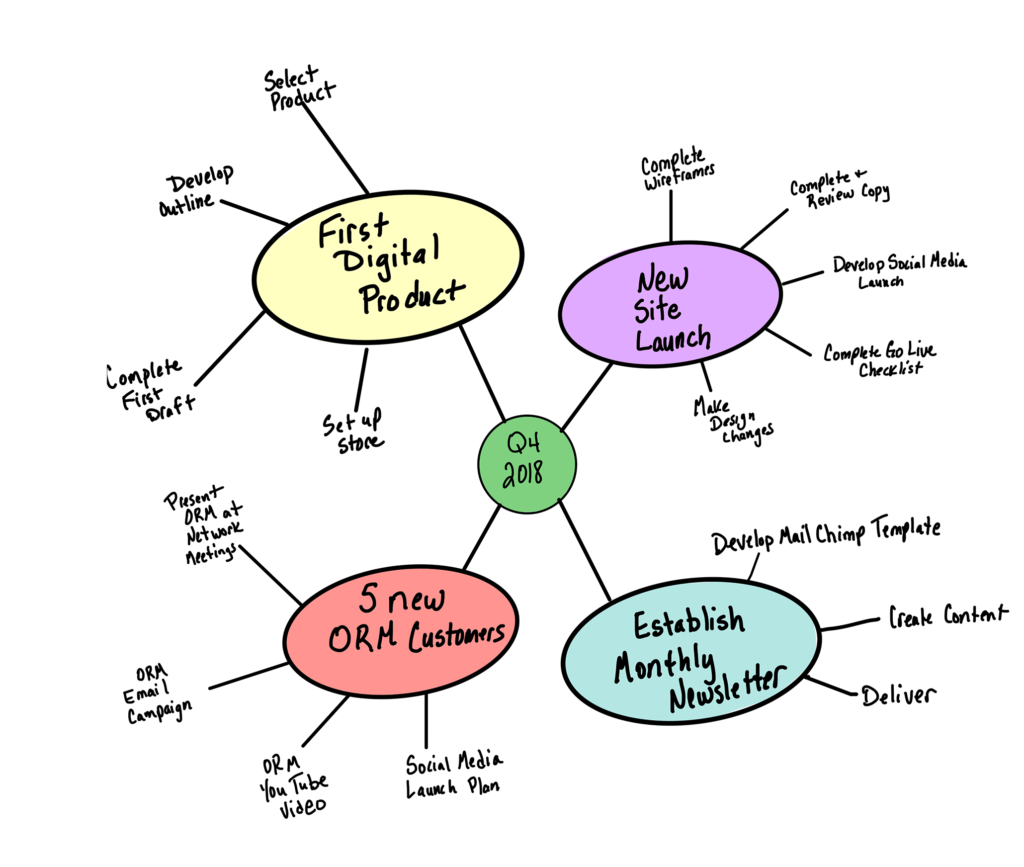The Secret to Losing 100 lbs. AND Changing Your Business

(image above) Nieto Creative goal planning a.k.a. “entrepreneurs date night.” Wine and dog can be key success factors.
I was 30 years old and had just recently had my second son when I saw a picture of myself in a company newsletter. I barely recognized myself. At that moment I realized that I had been overweight my entire life and I was desperate to do something about it. I needed to lose about 100 lbs. I immediately joined Weight Watchers and had some small success in the beginning but it was a big goal and seemed impossible to overcome. Then I came across a book that changed everything – Body for Life: 12 weeks to Mental and Physical Strength. It made sense and it gave me a deadline. I thrive on deadlines. After three 12 week periods, I achieved my goal of losing 100 lbs. and have applied the 12-week timeframe to my personal and business goals ever since.
How to Achieve Exceptional Business Results using a Simple 12-Week Goal Setting Plan
The same three principles that applied to my weight loss success applies to achieving exceptional business results.
- Set SMART Goals
- Create an Action Plan
- Scheduled Goal Check-ins
Ready to take your business to the next level? We are going to show you how to create a 12-week goal setting plan for your business.
Let’s start with some key points:
A 12-week plan accomplishes three things:
- It is easier to think about the next three months, as opposed to the next 12 months.
- It allows flexibility. After three months you get to change it.
- The goals are usually more realistic. When you only have 12 weeks you tend to focus on what is truly possible since you can usually see three months into the future.
Don’t get me wrong. We do set annual business goals and measure our plan against that. However, we do revisit our annual goals quarterly to ensure they are still applicable.
Don’t overthink it.
It may feel overwhelming, remember to just take it one step at a time. Don’t worry about all the steps, just take the next one. Sometimes the hardest thing to do is just start.
Don’t wait.
There is no magic time to start. It doesn’t have to be the first day of the month or the first day of the quarter. Today is always the best day.
Don’t overcommit.
If you haven’t set goals in a while you might decide to list ALL your goals. This can end up hurting you in the end. Try to focus on no more than 5 high-value goals per quarter. If your list is longer than that, consider pushing them to the next quarter.
Understand what has worked in the past and what hasn’t.
Spend some time reflecting on past successes and failures. What can you learn from your past that can help you in the next 12-weeks?
Ask yourself these questions:
- If I look forward in 12 weeks and I have not met these goals what may have been the reason?
- What would I wish I would have done differently?
- What actions have I taken in the past that was successful?
- Is there something that will get in the way of me achieving these goals?
Identifying risks and then making a plan to mitigate those risks if they actually happen will keep you on track and lessen the possibility of getting derailed.
Our 4 Step Process
Step 1: Establish 90 Day SMART Goals for Exceptional Results
I can’t emphasize enough that you must set SMART goals! What get’s measured, get’s done.
Specific – Avoid general terms of intent and make sure they are outcome focused. Ex. Attend QuickBooks training is a process-oriented statement while “prepare my financial statement for quarter accountant review” would be outcome-oriented.
Measurable – Goals should be measurable and important. For example, it would be more important to measure the number of new clients you signed vs. the number of network events you attended.
Aggressive – This is another reason we prefer 12-week goals12-month month goals. Aggressive goals do two things – put a sense of urgency to the goal and causes us to stretch. Even if we don’t achieve them, we often have grown more than if we had set conservative goals.
Realistic – Realistic is not the opposite of aggressive. A realistic goal should be in line with your strengths, within your control and aligned with your interests (this will support self-motivation) but should also feel a little impossible. Stretch yourself!
Time-bound – Set a deadline and smaller milestones. The smaller milestones will help you see if you are on track to meet the deadline.
Here are a few of our 12-week SMART goals:
- Launch redesigned site by end of October.
- Establish a monthly newsletter.
- Sign 5 new Online Reputation Management customers by end of 4th quarter.
- Create our first digital learning product by end of 4th quarter.
Step 2: Brainstorm the Action Items for Each Goal
Far too often people will create goals and then stop there hoping they magically come true. You have to come up with an action plan. I am a big fan of mind mapping our action plan first. Here is an example of a mind map based on the goals above.

Step 3: Schedule your Action Items
Get these on a calendar that you see often. We use Trello to assign and set due dates on the action items. You can view them as cards or change to a calendar view.
CARD VIEW:

CALENDAR VIEW

Step 4: Schedule a monthly check-in
Schedule a monthly check-in on your calendar. Really schedule it. This is an important step in achieving your goals. I can’t emphasize it enough. It will help you understand if you need to adjust and will also provide some positive reinforcement for the successes from the previous month.
Now get to it!!
